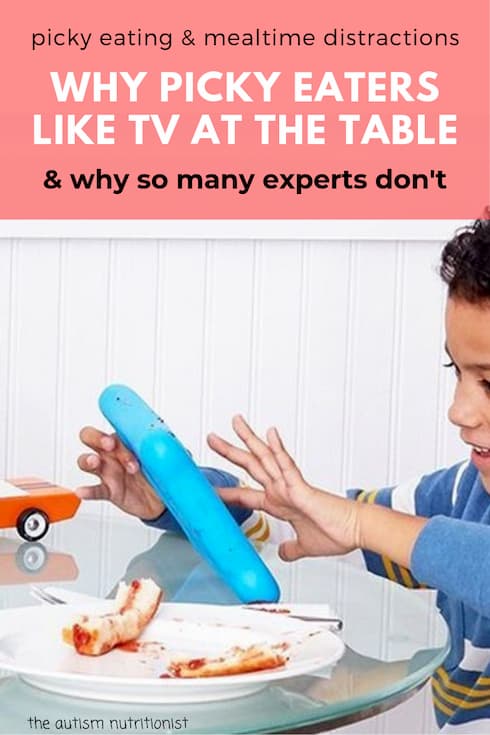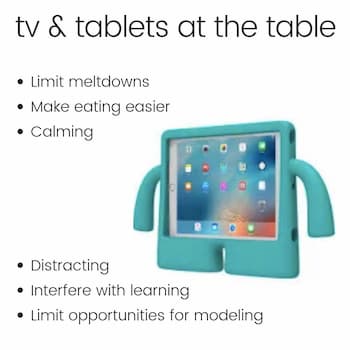
TV or no TV during meals?
What about tablets and toys?
Many parents resort to mealtime distractions like screens, TV, tablets, books, and toys because they are the only thing that gets their children to sit down and eat.
Mealtime distractions have a bad reputation. Which is why I was initially (somewhat) surprised to learn that over 50% of my community on Facebook and Instagram report their child eats with a distraction.
The thing is, distractions don’t earn a seat at the table because parents are neglectful, lazy, or think their child actually needs more screen time. Rather, a mealtime distraction is a coping mechanism. Both picky eaters and their parents can benefit from a distraction at mealtimes. Which is why when you think about it, it’s not so surprising that parents of picky eaters, children on the autism spectrum, and those with sensory food aversions resort to mealtime distractions.
The reality is that there are pros and cons to distractions at the dinner table.
Why Mealtime Distractions Can Help Picky Eaters
A common pro is that your child eats and actually sits still. These are invaluable benefits for any selective eater, but are especially important for a child who struggles with to maintain their weight or meet their nutritional needs. Parents tell me that without a mealtime distraction, their child just won’t eat. Picky eaters find distractions helpful because they make their discomfort with eating more comfortable. As in nothing. It’s not surprising that a parent who is worried about their child’s nutrition, growth, and health welcomes a distraction that solves the problem.
Some parents share that they use distractions as part of the desensitization process when introducing new foods. The distraction is there for the first few encounters, but can be faded out when a child is more comfortable with a new food.
Others share that they use distractions like tablets or headphones only in stressful and triggering situations like eating in a restaurant or when travelling.

Why Mealtime Distractions Don’t Help Picky Eaters
The downside of using distractions at mealtimes is that children won’t learn to overcome their eating challenges. Kids often eat better with distractions because they mitigate the discomfort a child experiences with eating. Kids with sensory issues, for example, may prefer to eat with a distraction because it helps them ignore sensory stressors.
In this case, a distraction is a band aid. If your goal is to for your child learn to eat new foods or overcome sensory food aversions, a distraction is not helping.
Furthermore, there are many benefits to being present at mealtimes. When kids are not distracted at meals they can interact with and observe other members of the family and notice the food they are eating and how.
This is the reason why you hear me recommending a distraction-free table – no books, no clutter, no toys, no TV, no tablets. Just a clear table where food is the most interesting thing around.
Recap
If you are using a mealtime distractions at the table you’re probably doing so for a good reason. Distractions can help kids eat more and sit at the table more comfortably.
Homework
If you’re intrigued about distraction-free meals, evaluate your why and your goals.
Why did mealtimes happen in the first place? Is it present because it’s become a habit? Is it’s necessity to get your child to eat?
What about your goals? Are you working to increase or maintain or child’s weight? Trying to introduce new foods? Trying to resolve sensory food aversions?
If you’re ready to make some changes, consider my Mealtime Makeover program. We’ll work together to make your family meals distraction-free, calm, successful, and enjoyable for everyone.
Want to see the end if mealtime distractions? Check out my 5 easy tips below
Picky Eating and Mealtime Distractions: How to Eliminate TV at the Table



Great Resources!